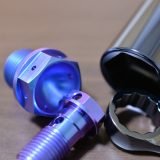Anodize

What is Anodizing used for?
Dyeing is another popular application of anodized aluminum. The aluminum oxide layer that is created on an aluminum alloy during the anodizing process is porous. This allows some dyes to be absorbed by the oxide layer. Aluminum alloys that couldn’t be dyed before can now be made to be a variety of colors.
Applications of dyeing anodized aluminum include knobs and body housings. Since aluminum oxide is not nearly as conductive as aluminum, it can be also used for electrical insulation purposes such as electric car battery terminals and cable pins.
What metals can be anodized?
Practical uses of anodizing
 Anodizing is a method for changing the surface chemistry of metals and other substrates. It protects against corrosion, enhances aesthetic qualities, resists scratching and is one of the most durable surface finishes available. There are 3 common anodizing processes for precision machine parts, Chromic acid anodizing, Sulfuric acid anodizing, and Hard anodizing.
Anodizing is a method for changing the surface chemistry of metals and other substrates. It protects against corrosion, enhances aesthetic qualities, resists scratching and is one of the most durable surface finishes available. There are 3 common anodizing processes for precision machine parts, Chromic acid anodizing, Sulfuric acid anodizing, and Hard anodizing.
Chromic acid anodizing is an electrochemical process to thicken the natural thin oxide layer on the surface of aluminum in chromic acid solution to improve the scratch resistance and corrosion resistance of aluminum parts. The thickness of the anodic oxide film obtained by chromic acid anodizing is 2 – 5μm, and since the thickness of the oxide layer is thin, the parts can still maintain their original precision and surface roughness, so the process is suitable for precision parts.
Aluminum and its alloys are anodized in dilute sulfuric acid electrolyte with direct or alternating current. A colorless transparent oxide film of 5 – 20μm thickness with good adsorption can be obtained. When the quality concentration of sulfuric acid is high, the chemical dissolution of the film is accelerated, and the resulting film is thin and soft, with more voids, strong adsorption and good dyeing performance. Decrease the quality concentration of sulfuric acid, then the oxide film grows faster, and the void rate is lower, the hardness is higher, and the wear resistance and reflectivity are good.
Hard anodizing mainly improves various properties of aluminum alloys, including corrosion resistance, wear resistance, weather resistance, insulation and adsorption. Under the anodic treatment of cooled dilute sulfuric acid oxidation solution, high hardness and thick oxide film can be obtained, which is suitable for both deformed aluminum alloys and precision aluminum alloy parts. The thickness of hard anodic oxide film is generally required to be 25 – 150μm, and the thickness of most hard anodic oxide films is 50-80μm. Hard anodic oxide films with film thickness less than 25μm are used for parts in applications such as tooth keys and screws, and the thickness of anodic oxide film for wear resistance or insulation is about 50μm.
More surface finishing services
We are an efficient and cost-effective one-stop solution provider with the scale and capability to deliver integrated services.